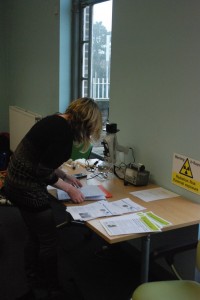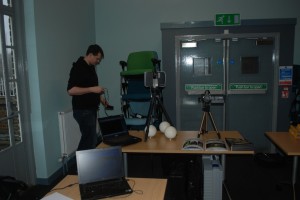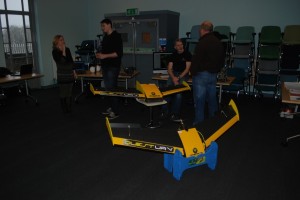Photographs into Models: Documenting the World Trade Center Ship
By Carrie Fulton If you attend any archaeology conference or glance through recent issues of…
 A recent SHA Academic and Professional Training Student Sub-committee survey asked student members what technologies are necessary in archaeology and as professionals. In continuing support of the identification, discussion, and application of relevant technologies, student member, Tim Goddard, agreed to (re)introduce the concept behind the Technology Room – a great space for students and professionals to engage in one-on-one conversations about current technologies in historical archaeology.
A recent SHA Academic and Professional Training Student Sub-committee survey asked student members what technologies are necessary in archaeology and as professionals. In continuing support of the identification, discussion, and application of relevant technologies, student member, Tim Goddard, agreed to (re)introduce the concept behind the Technology Room – a great space for students and professionals to engage in one-on-one conversations about current technologies in historical archaeology.
Thank you for the opportunity to blog about the Technology room from/for a student’s perspective. I gladly serve on the SHA’s Technology committee. I am also a Graduate student finalizing my PhD. Several years ago, when I first joined the committee, one of my first conversations with fellow members explored the challenges of presenting the use of technology to SHA members who were not already a part of the “technology crowd”. For many previous years, the same group of colleagues presented the latest technologies they were playing with and composed the small number of technology sessions at annual meetings. Despite the fun of this, rarely did we see new faces – especially people wanting to learn about technology.
The Technology Committee was created to serve the SHA’s needs as they relate to technology. This can include almost anything, which has been the case thus far. Only the Website has remained outside the purview of the technology committee. We serve to advise the SHA board and any interested members on almost any technology-related application, either for the Society, or for use in the field of archaeology. As you can imagine, this is an extensive scope. The diverse technical needs of archaeologists require that the committee have a number of members from a wide variety of technological backgrounds. We cover topics including: social media, geophysics, remote sensing, data collection, data management, GIS, LIDAR, 3D, virtual worlds, network management, etc.

pXRF Technology Leicester 2013. PxRF technology allows us to identify the chemical composition of soils and/or artifacts. The committee regularly offers workshops at the SHA to learn how to use this technology. The following link is an example of one use by one of our committee members David Morgan (http://ncptt.nps.gov/blog/pxrf-presentation-at-lasmaa/).
With some of my own work in WebGIS, I was frustrated that it was not possible to demonstrate my research in a virtual poster session allowing people to view and interact with my presentation via a computer terminal. To do so would have meant me renting a table space, electricity and Wi-Fi, in the exhibition room. Something that is not really feasible for most students! I also know firsthand from teaching that there are a large number of archaeologists that have technology phobias. This fear can be found in young students as well as established emeritus colleagues around the world. So I wanted to know how we could better serve those members at the conferences. We developed the idea of the Technology Room.
Our first experiment with a dedicated technology demonstration space was at the 2011 meeting in Austin, Texas. We decided to focus on three to four key technologies that we felt every archaeologist should know about. We found a handful of our colleagues working with these technologies and invited them to bring the actual technology to our room and to sit down for a block of time to answer questions and provide demonstrations, and hands on experience were possible, for interested colleagues. We strove to recruit archaeologists using technologies in their research projects rather than sales representatives. The idea was great and we got positive feedback, but our execution that first year needed some help.

LIDAR technology Leicester 2013. LIDAR typically comes in aerial or terrestrial applications. This is a terrestrial style scanner being demonstrated in the Technology Room. A good link to see LIDAR uses in heritage is http://archive.cyark.org/?gclid=CPX7m8a13boCFQLl7AodR0oAXw.
In the following years we continued to showcase various technologies by having practicing archaeologists demonstrate the technology in the exhibition room, which was always problematic and also made communicating difficult with all the noise. Last year, in Leicester, was the first year that we had our own dedicated room, making communicating much easier. We saw a drop in traffic indicating that we still need to get the word out there about the Technology Room. An undergraduate student who I supported at Leicester found the Room worth noting in a blog he posted about his first conference experience. There is something for everyone in the Technology Room.

UAV Technology Leicester 2013. Unmanned Aerial Vehicles are popping up everywhere in archaeology. From a simpler Quadcopter to multiple thousand dollar units with multiple sensor platforms are finding many uses every year in archaeology.
What are the purposes of the Technology Room?
What is the benefit to Students? Students:
So I challenge you:
What Technology are you interested in? What role do you feel technology should play in archaeology? What are the problems we face with technology? How can we (SHA) or your institution better train you for technology-related applications?
Comment below as well as stop by the Technology Room this January.
Tim Goddard